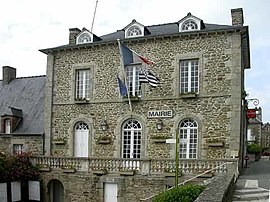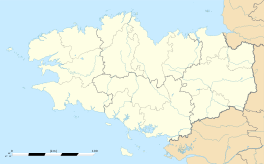Saint-Briac-sur-Mer
|
Saint-Briac-sur-Mer Sant-Briag |
||
|---|---|---|
| Commune | ||

The town hall of Saint-Briac-sur-Mer
|
||
|
||
| Coordinates: 48°37′16″N 2°07′58″W / 48.6211°N 2.1328°WCoordinates: 48°37′16″N 2°07′58″W / 48.6211°N 2.1328°W | ||
| Country | France | |
| Region | Brittany | |
| Department | Ille-et-Vilaine | |
| Arrondissement | Saint-Malo | |
| Canton | Saint-Malo-2 | |
| Intercommunality | Côte d'Emeraude | |
| Government | ||
| • Mayor (2014–2020) | Vincent Denby-Wilkes | |
| Area1 | 8.06 km2 (3.11 sq mi) | |
| Population (2009)2 | 1,955 | |
| • Density | 240/km2 (630/sq mi) | |
| Time zone | CET (UTC+1) | |
| • Summer (DST) | CEST (UTC+2) | |
| INSEE/Postal code | 35256 /35800 | |
| Elevation | 0–62 m (0–203 ft) (avg. 40 m or 130 ft) |
|
|
1 French Land Register data, which excludes lakes, ponds, glaciers > 1 km² (0.386 sq mi or 247 acres) and river estuaries. 2Population without double counting: residents of multiple communes (e.g., students and military personnel) only counted once. |
||
1 French Land Register data, which excludes lakes, ponds, glaciers > 1 km² (0.386 sq mi or 247 acres) and river estuaries.
Saint-Briac-sur-Mer (Breton: Sant-Briag, Gallo: Saent-Beriac), is a commune in the Ille-et-Vilaine Department in Brittany in northwestern France.
Inhabitants of Saint-Briac-sur-Mer are called briacins in French.
St Briac lies on the Gulf Stream which means it enjoys a warm climate, several degrees warmer than the surrounding areas. The village has fine examples of tropical palms and plants, along the streets, making strolls very enjoyable.
Saint Briac has two campsites, seven beaches, four tennis courts, one soccer field, a yacht club, one mini golf, one 18 hole golf course, and more than 5 restaurants.
The name Saint Briac comes from the name of Saint Briac, an Irishman. Briac arrived from Ireland with Saint Tugdual in around 548.
On 4 and 5 September 1758, a British fleet of 113 ships under the command of Admiral Richard Howe, landed east of the Garde Guerin, in Saint Briac. With a force of more than 12,000 men, under the command of General Thomas Bligh, who accompanied the Duke of York, the future king George III, they established camp in neighboring St Lunaire, but not before pillaging and burning down more than half of Saint Briac.
Le Chateau du Nessay (seen below) was built on an emplacement of a castle originating from the 12th century. During the French Revolution, it was used as a prison, to hold political prisoners.
...
Wikipedia



